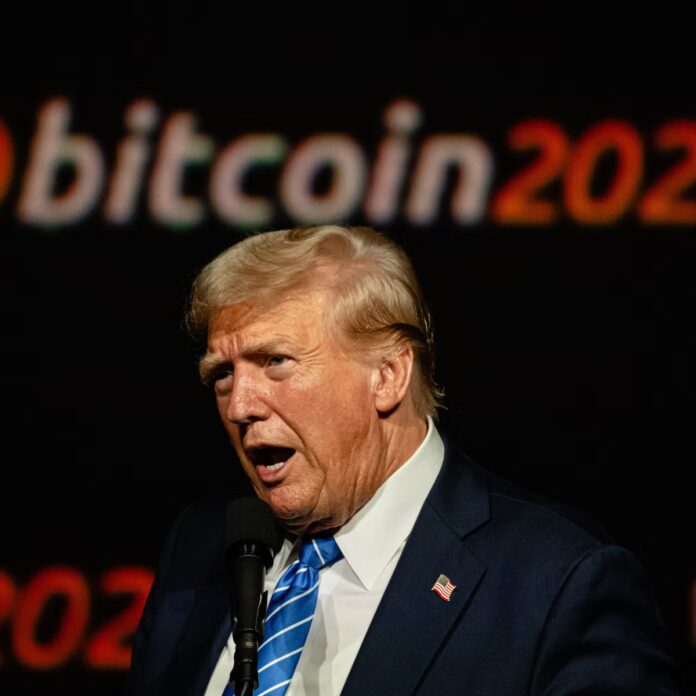Bitcoin has reached a historic milestone, smashing through the $100,000 barrier for the first time. Investors celebrated this achievement as a turning point for cryptocurrencies, spurred by U.S. President-elect Donald Trump’s pro-crypto stance and his nomination of blockchain advocate Paul Atkins to lead the Securities and Exchange Commission (SEC). Bitcoin surged to an all-time high of $103,619 during Thursday’s Asian trading hours, before stabilizing at $102,650.
The milestone highlights Bitcoin’s growing acceptance in mainstream finance. Once a niche asset viewed with skepticism, Bitcoin’s value has more than doubled in 2024 alone, fueled by institutional adoption and clearer regulatory pathways under a crypto-friendly U.S. administration.
Trump’s Crypto Agenda: A Catalyst for Growth
Donald Trump’s election victory has ushered in a wave of optimism among crypto proponents. His campaign vowed to make the United States the global leader in cryptocurrency, a sentiment echoed in his appointment of Paul Atkins to the SEC. Atkins, a respected figure in blockchain circles and co-chair of the Token Alliance, is expected to shape policies favorable to digital assets.

“Paul Atkins’ appointment is a pivotal moment,” said Kristin Smith, CEO of the Blockchain Association. “We are entering a new era of American crypto innovation.”
Trump’s vision includes establishing a crypto advisory council to foster collaboration with industry leaders. Companies like Ripple, Kraken, and Circle are already vying for a role in this initiative.
A New Era for Bitcoin and Digital Assets
Bitcoin’s rise to six figures reflects its evolution from a speculative asset to a legitimate financial instrument. Its current market capitalization, nearly $3.8 trillion, now rivals that of Apple (AAPL.O), showcasing its growing clout.
“We’re witnessing a paradigm shift,” said Mike Novogratz, CEO of Galaxy Digital. “Bitcoin and digital assets are entering the financial mainstream. This momentum is fueled by institutional interest, advancements in tokenization, and a more defined regulatory environment.”
Institutional investors have played a pivotal role in Bitcoin’s rally. U.S.-listed Bitcoin ETFs, approved earlier this year, have funneled over $4 billion into the market since November. “Institutional money has purchased roughly 3% of all bitcoins that will ever exist in 2024,” said Geoff Kendrick, head of digital assets research at Standard Chartered.
Riding the Crypto Wave: Stocks and Companies Soar
Bitcoin’s rally has also lifted crypto-related stocks. Shares in Bitcoin miner MARA Holdings (MARA.O) and exchange operator Coinbase (COIN.O) climbed 65% in November. Meanwhile, MicroStrategy, known for its Bitcoin reserves, has seen a staggering 540% increase in stock value this year.

Even President Trump has entered the crypto arena with his venture, World Liberty Financial, unveiled in September. While details remain sparse, the move signals his administration’s dedication to fostering crypto innovation.
Challenges Persist Amidst Optimism
Despite the euphoria, Bitcoin’s critics point to unresolved challenges. The industry faces scrutiny over energy consumption, crime-related activities, and its uneven impact on financial systems. Just this week, U.S. and British authorities dismantled a money-laundering ring using cryptocurrencies to evade sanctions and fund criminal operations.
However, Bitcoin’s longevity and resilience cannot be ignored. After weathering major crashes, including a dip below $16,000 during the FTX debacle of 2022, it has rebounded spectacularly. As Vladimir Putin remarked, “Who can prohibit it? No one.”
The Future of Bitcoin: Mainstream and Beyond
Bitcoin’s journey to $100,000 is more than a financial milestone—it represents the dawn of a new era for decentralized finance. Institutional adoption, regulatory support, and public enthusiasm are converging to drive its integration into global financial systems.

With a pro-crypto administration at the helm and a robust ecosystem of supporters, Bitcoin’s future seems brighter than ever. As it cements its place in the financial landscape, the cryptocurrency’s rise signals the arrival of a digital revolution that could reshape the world of money for generations to come.

